A Homeowner's Complete Guide to DIY Termite Treatment
So, you think you have termites. Before you run screaming for the hills (or for your wallet), let's talk about handling it yourself. DIY termite control can save you a bundle... or it can go horribly wrong. This guide breaks down what you need to know, from identifying your tiny enemies to deciding if going pro is the smarter move.
Understanding the Enemy
Why Go DIY?
Thinking about DIY termite control? It usually comes down to two things, saving money and wanting to act FAST. Seeing signs of termites is scary, and waiting for a professional can feel like torture.
The idea of grabbing a product off the shelf and immediately fighting back is tempting. You feel in control, protecting your biggest investment with your own two hands. But this path has some serious risks that aren't printed on the bottle.
The Silent Destroyers
Termites are sneaky. They eat your house from the inside out, often for years, without any obvious signs. They're not like ants in the kitchen, a failed termite treatment means they just keep eating. 6
By the time you see sagging floors or wood that sounds hollow, major damage might already be done. 6 This makes termite control a high-stakes game. A failed treatment lets the destruction continue, and most homeowner's insurance won't cover the repair bill. 8
Know Your Termite: Subterranean vs. Drywood
This is the big one. Get this wrong, and you've wasted your time and money. 11 Using the wrong treatment is like trying to fix a leaky pipe with a hammer, it's completely useless and just makes a bigger mess.
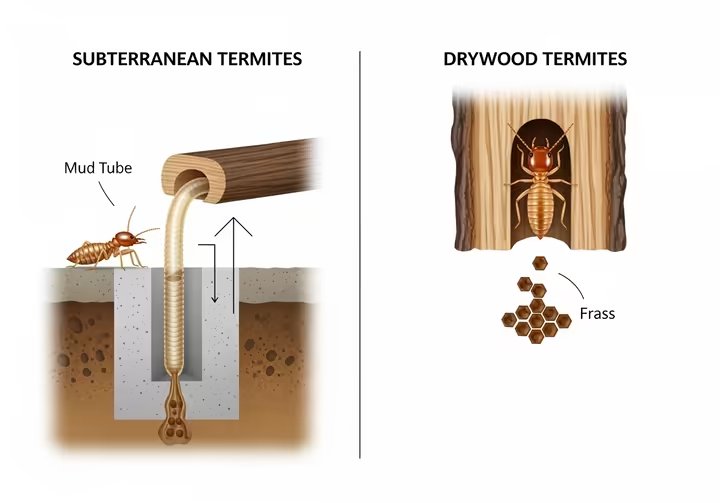
Subterranean termites live underground in huge colonies and need moisture from the soil. 13 They build little mud tubes to commute to their job (eating your house). You have to treat the soil to create a barrier and stop them. 12
Drywood termites live inside the wood. 12 They don't need soil, they get all the water they need from the wood they're eating. Treating the soil does absolutely nothing to these guys, you have to treat the wood itself. 11
DIY vs. Pro: The Big Decision
Choosing between DIY and a pro isn't just about saving a few bucks. It’s about weighing the upfront cost against the risk of a massive, expensive failure. Let's break it down.
Who's Better at Killing Termites?
Professionals usually win this one. They're trained to spot the exact species and know the sneaky ways termites get into your specific type of house. 8 Their treatment is a custom plan to wipe out the whole colony.
DIY treatments are often just a surface-level attack. You might kill the termites you can see, but the main colony deep in the ground or walls is left unharmed, ready to rebuild and keep munching. 1
Guarantees (The Pro's Secret Weapon)
This might be the biggest reason to hire a pro, they offer a warranty. 10 If termites come back, so do they, for free. Some warranties even cover the cost of new damage. 17
You pay an annual fee to keep this protection active, like an insurance policy for your house's skeleton. With DIY, you're on your own. If it fails and termites eat your floor joists... good luck. 10
The Real Cost
DIY seems cheap upfront, but add it all up. You need the chemicals, plus gear like a commercial-grade drill for concrete, shovels for trenching, and safety equipment. 19 It can easily run into hundreds of dollars.
A pro costs more initially, maybe a few thousand dollars plus an annual renewal fee. 22 But what's the hidden cost of a failed DIY job? Structural repairs can hit $10,000 or more. 19 Suddenly, that pro quote doesn't seem so bad.
The Gear Gap
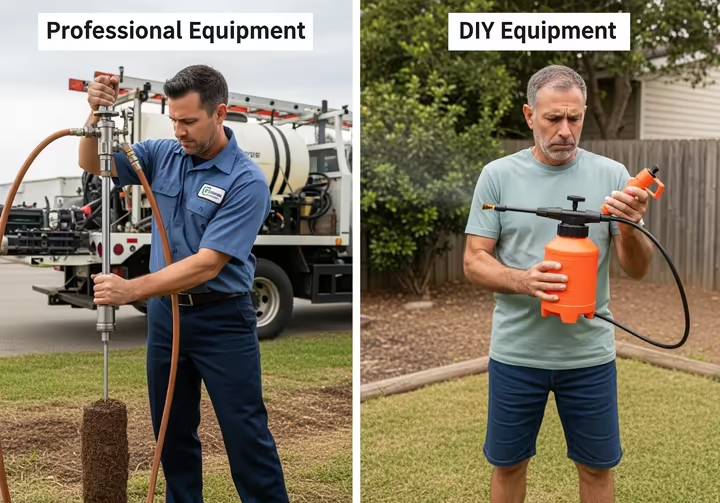
Professionals get the good stuff. They have access to restricted-use chemicals that are stronger and last for years. 8 Products like Termidor and bait systems like Sentricon are the gold standard, and you can't legally buy them yourself. 16
You're stuck with the weaker, off-the-shelf versions. 9 A pro with a high-pressure soil injector versus you with a garden sprayer, it's like bringing a squirt gun to a firefight.
Safety and Legal Stuff
Termite-killing chemicals are no joke. Professionals are trained, licensed, and insured to handle them safely. 8 When you go DIY, you take on all that risk yourself.
A mistake could harm your family, your pets, or the local wildlife. If you contaminate your neighbor's well, you're the one on the hook for it. 30
| Feature | DIY Approach | Professional Service |
|---|---|---|
| Success Rate | Low. High risk of failure and termites returning. 1 | High. A trained pro targets the whole colony. 8 |
| Guarantee/Warranty | None. You're 100% responsible for all damage. 10 | Yes. Covers retreatment and often new damage repair. 17 |
| Upfront Cost | Lower. A few hundred dollars for products and tools. 22 | Higher. Often a few thousand dollars for full treatment. 23 |
| Long-Term Financial Risk | Extremely high. Potential for massive repair bills. 25 | Low. Predictable annual fee for the warranty. 17 |
| Products & Technology | Consumer-grade chemicals with weaker formulas. 9 | Pro-grade, restricted-use chemicals and bait systems. 16 |
| Required Knowledge | A lot. You need to learn about termites, chemicals, and safety. 9 | None. You just hire a licensed and trained expert. 1 |
| Labor & Time | A ton. Days of digging, drilling, and hard physical work. 19 | Almost none. Just be home to let them in. 26 |
| Safety & Liability | All on you. You're responsible for any accidents or contamination. 30 | Company is licensed and insured, protecting you from liability. 8 |
Your DIY Toolkit
Still set on doing it yourself? Okay, let's look at the main weapons in your arsenal. Using the right tool for the job is everything, and a misstep can mean total failure.
Liquid Soil Treatments: The Chemical Moat
The most common DIY method is creating a poison barrier in the soil around your house. 16 But one tiny gap in that barrier, and the termites will pour through it, making all your hard work worthless.
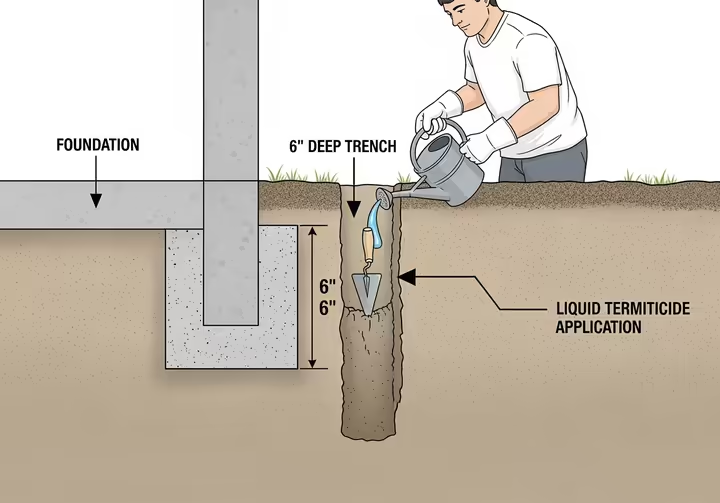
Modern chemicals are undetectable. Termites walk through the treated soil, get the poison on them, and carry it back to the nest like a tiny Typhoid Mary, spreading it to others. 36 The hard part is the application, it means digging a six-inch trench all the way around your house and drilling holes through any concrete patios or walkways. 34
Termite Baiting Systems: The Slow-Burn Ambush
This is a less sweaty option, but it requires a lot of patience. 43 You plant these plastic stations, filled with yummy poisoned wood, around your home's perimeter. Worker termites find the bait, share it with the colony, and it slowly kills them all off. 43

The catch? You have to check the stations. Constantly. 44 If you don't inspect them every few months, you'll never know if they're working or if the termites have even found them. Forget to check, and you're back to square one.
Borate Treatments for Wood: Poisoning the Buffet
This method is for prevention, not for killing an active subterranean colony. You spray a borate solution on raw, unpainted wood. The wood soaks it up and becomes permanently toxic to any termite that tries to eat it. 48
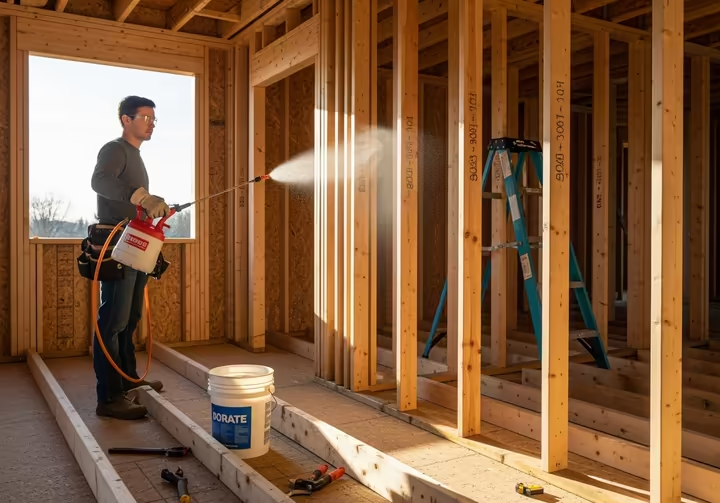
It's perfect for new construction when all the wood framing is exposed. 47 But it's useless on painted or sealed surfaces, the borate can't soak in. 50 Spraying a painted window sill will do nothing.
Direct Chemical Foams and Sprays: The Surgical Strike
Think of foam like a sniper rifle, not a bomb. It's great for zapping a small, known spot of activity, like inside a wall void. 27 You drill a small hole and inject the foam, which expands to fill the space and kill termites on contact.

The huge limitation is that it only kills the termites it touches. 53 It does nothing to the main colony in the soil. It's easy to think you've won the war when you've only taken out a single patrol.
Real-World Termite Problems
Let's look at how these methods apply to real-life situations. The key takeaway? Proactive prevention is manageable for a DIYer. Reacting to a hidden, established colony is a whole other story.
"Help! I Found Termites in My Wall!"
You see a mud tube or hear a faint munching sound from the drywall. The common DIY move is to drill a hole and shoot some insecticidal foam in there. 34 The foam expands, kills the foragers in that spot, and the visible activity stops.
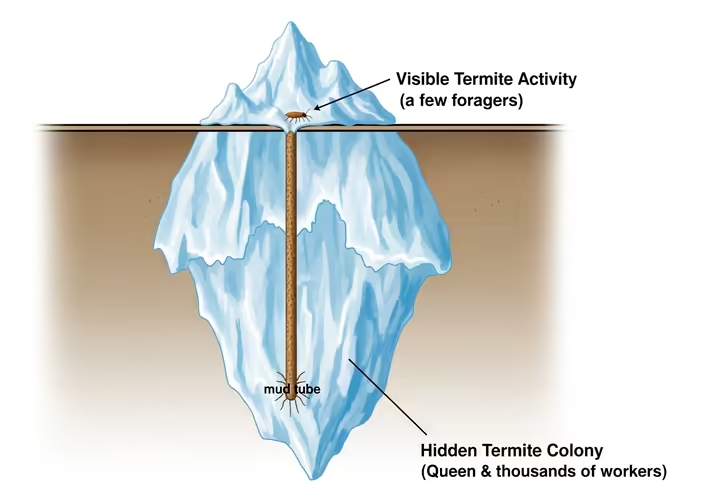
The problem is, that's almost certainly just the tip of the iceberg. 8 The main army, the colony and its queen, is probably outside in the soil, completely unharmed. 53 You've killed a few scouts, but the invasion continues silently somewhere else.
"I'm Building a New Home!"
Now you're talking! This is the absolute best time for DIY termite control. While the house is just a wooden skeleton, you have a golden opportunity to put up some powerful defenses.
Before the drywall goes up, you can use a simple sprayer to coat every piece of raw lumber with a borate solution. 47 You're basically making the house's entire frame poisonous to termites from day one. You can also make sure the builder doesn't bury any scrap wood near the foundation, which is like leaving out a welcome mat for termites. 56
"What do the Pros Use?"
The pros use the big guns, stuff you can't get at the store. Besides stronger chemicals and patented bait systems, they have options for catastrophic infestations. 16
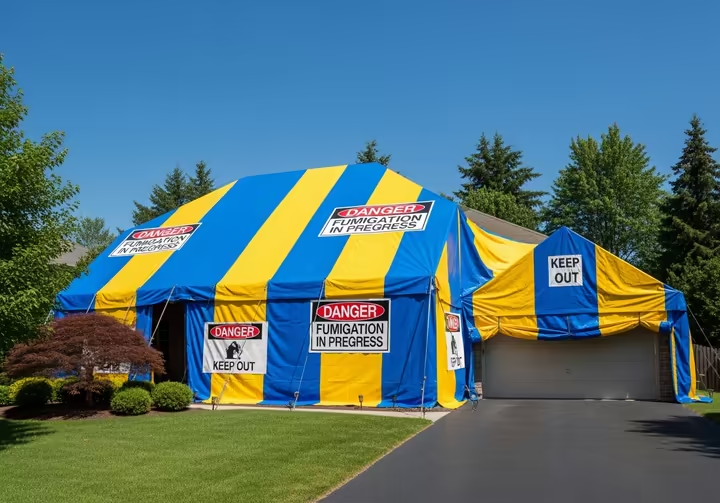
One method is whole-structure fumigation, or "tenting." 59 They cover your entire house in a giant tarp and pump in a gas that kills every last termite inside. 60 Another is whole-structure heat treatment, where they tent the house and bake it until the termites are cooked. 62
Yeah... you can't do that yourself. It shows that what might seem like an impossible problem to you is just a standard (though expensive) procedure for a professional.
The Not-So-Fun-But-Very-Important Stuff
When you decide to apply these chemicals, you become a pesticide applicator. That comes with big responsibilities for your safety, the law, and the environment. You're basically an uninsured amateur, taking on all the risk a pro is trained to avoid.
The Label is the Law
That little instruction booklet on the pesticide bottle? It's not a suggestion, it's a legally binding document. 65 Using a pesticide in any way that's not on the label, like mixing it stronger or spraying it in the wrong place, is a violation of federal law. Seriously.
Gearing Up for Safety: Essential Protective Equipment (PPE)
Don't be a hero, wear the gear. The product label will tell you what you need. This usually means a long-sleeved shirt, long pants, and chemical-resistant gloves (your leather work gloves won't cut it). 67
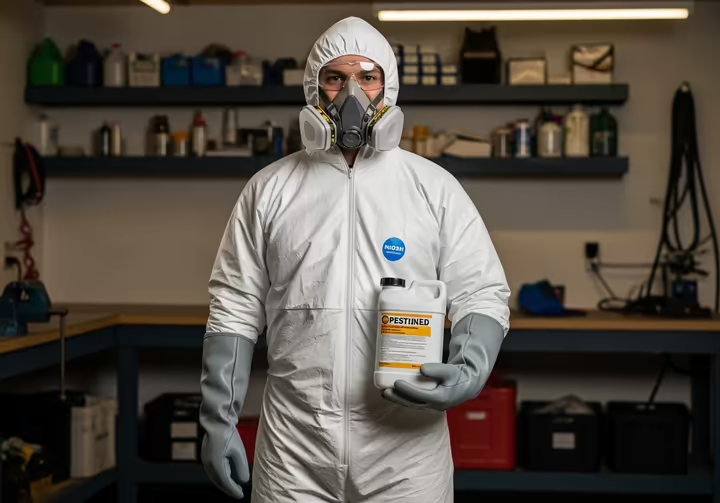
You'll also need chemical splash goggles to protect your eyes. If you're working in a tight space like a crawlspace, you need a NIOSH-approved respirator. Remember, this stuff is designed to be poison. 67
Beyond Your Foundation: Environmental Impact
The chemicals that kill termites are also really bad for bees, fish, and other critters. 37 If you use too much or apply it right before a big rain, it can wash off your property into storm drains. 31
Those drains often lead directly to local rivers and lakes. One mistake on your property can end up polluting a public waterway. Be careful out there. 74
The Aftermath: Proper Disposal
You're not done when the spraying stops. Leftover, concentrated chemicals are household hazardous waste. Never pour them down a drain or put them in the trash. 75 Contact your local waste authority to find a hazardous waste drop-off event. 77
Empty containers need to be triple-rinsed right away. The rinse water, "rinsate," should be poured into your sprayer and used as part of the application, never on the ground. 78 Then, puncture the clean container so no one can reuse it and dispose of it according to your local rules.
Works cited
- DIY vs. Professional Termite Control: Pros and Cons - Arizona ..., https://arizonatermitecontrol.org/diy-vs-professional-termite-control-pros-and-cons/
- Professional vs. DIY Pest Control, https://www.allamericanpestcontrol.com/blog/post/professional-vs-diy-pest-control
- Pros and Cons of DIY Pest Control | Household Pests - Northwest Exterminating, https://www.callnorthwest.com/2024/09/pros-and-cons-of-diy-pest-control/
- DIY vs. Professional Pest Control: Making the Right Choice, https://www.graduatepestsolutions.com/our-blog/diy-vs.-professional-pest-control-making-the-right-choice
- Understanding Termites: Biology, Behaviour, and Signs of Infestation | Adaptive Pest Control, https://adaptivepest.com.au/understanding-termites-biology-behaviour-and-signs-of-infestation/
- Do DIY Termite Treatments Work? | Termite Control - Orkin, https://www.orkin.com/pests/termites/termite-control-methods/diy-termite-treatment
- Tiny Pests, Big Mistake: The Truth About DIY Termite Checks - Hi-Tech Termite Control, https://www.hi-techtermitecontrol.com/blog/tiny-pests-big-mistake-the-truth-about-diy-termite-checks
- 12 Reasons Why You Shouldn't DIY Your Termite Control, https://manningspestcontrol.com/blog/12-reasons-why-you-shouldnt-diy-your-termite-control
- Why DIY Termite Treatment Can Be Risky for Homeowners, https://www.mightymitetermite.com/blog/dangers-of-diy-termite-treatment/
- Why Do-It-Yourself Termite Control Is a Bad Idea - National Exterminating, https://www.national-pest.com/blog/why-do-it-yourself-termite-control-is-a-bad-idea/
- The Differences Between Drywood and Subterranean Termites: How to Treat Them, https://www.mightymitetermite.com/blog/the-differences-between-drywood-and-subterranean-termites-how-to-treat-them/
- What's the Difference: Subterranean and Drywood Termites - Terminix, https://www.terminix.com/termites/types/subterranean-vs-drywood/
- Drywood vs. Subterranean Termites: Identifying the Differences and Prevention, https://aptivepestcontrol.com/pests/termites/drywood-termites/drywood-vs-subterranean-termites-identifying-the-differences-and-prevention/
- ENY-211/IG098: Drywood and Dampwood Termites - UF/IFAS EDIS, https://edis.ifas.ufl.edu/publication/IG098
- Drywood Termites vs Subterranean Termites - Nozzle Nolen, https://nozzlenolen.com/blog/drywood-termites-vs-subterranean-termites/
- Does DIY Termite Treatment Work? What You Need to Know, https://www.bugs.com/blog/does-diy-termite-treatment-work-what-you-need-to-know/
- The Complete Guide to Termite Warranties: What Homeowners Need to Know, https://neusetermiteandpest.com/blog/the-complete-guide-to-termite-warranties-what-homeowners-need-to-know
- Termite Treatment & Control - Terminix, https://www.terminix.com/termite-control/
- 6 Reasons Not to DIY Termite Control, https://neusetermiteandpest.com/blog/6-reasons-not-to-diy-termite-control
- Comparing the Cost of DIY and Professional Pest Control Services, https://pestextinct.com/comparing-the-cost-of-diy-and-professional-pest-control-services/
- Why Professional Termite Control is Better than DIY, https://www.mightymitetermite.com/blog/why-professional-termite-control-is-better-than-diy/
- DIY vs. Professional Termite Control: What You Need to Know - Wake Pest, https://www.wakepest.com/diy-vs-professional-termite-control-what-you-need-to-know/
- How Much Does Termite Treatment Cost? | Pricing Guide - WorkWave, https://insights.workwave.com/industry/pest-control/termite-treatment-cost-guide/amp/
- How much does termite control cost? Liquid treatment or bait stations? Termite Treatment Costs. - Walker Pest Management, https://www.walkerpestmanagement.com/how-much-does-termite-control-cost/
- Professional Termite Control vs. DIY Methods - Noosa Pest Management, https://noosapest.com/blog/professional-termite-control-vs-diy-methods/
- DIY vs. Professional Pest Control: A Yearly Cost Breakdown, https://specterservice.com/diy-vs-pro-a-real-cost-comparison-over-one-year/
- How to Get Rid of Termites Quickly & Effectively - Fairway Lawns, https://fairwaylawns.com/how-to-get-rid-of-termites-quickly-effectively/
- The Top 5 Termite Killers (2025) - Pest Control - This Old House, https://www.thisoldhouse.com/pest-control/best-termite-killers
- What Really Kills Termites? DIY Methods vs. Professional Treatments, https://www.877termite.com/articles/what-really-kills-termites-diy-methods-vs-professional-treatments
- The Dangers of DIY Termite Control: Why You Should Hire a Professional, https://www.milbergerpestcontrol.com/the-dangers-of-diy-termite-control-why-you-should-hire-a-professional/
- What Are The Risks Of DIY Termite Treatments? - Pro Defense Pest Control, https://www.prodefensepestcontrol.com/blog/what-are-the-risks-of-diy-termite-treatments/
- Termite FAQs - Texas Department of Agriculture, https://texasagriculture.gov/Regulatory-Programs/Pesticides/Structural-Pest-Control-Service/Termite-Fumigation-Applications/Termite-FAQs
- Termites: How to Identify and Control Them | US EPA, https://www.epa.gov/safepestcontrol/termites-how-identify-and-control-them
- Subterranean Termite Treatment Guide - DoMyOwn, https://www.domyown.com/subterranean-termite-treatment-guide-a-478.html
- How to Get Rid of Termites | Signs, DIY & Expert Tips, https://diypestcontrol.com/termite.htm
- Pros and Cons of Different Termite Treatments - Dodson Pest Control, https://www.dodsonbros.com/termites/pros-and-cons-of-different-termite-treatments/
- The Impact of Termiticides on Termite Corpse Management - PMC - PubMed Central, https://pmc.ncbi.nlm.nih.gov/articles/PMC11856413/
- How to Use Termidor SC [Termiticide & Insecticide] - YouTube, https://www.youtube.com/watch?v=5BNVjIuEEXk
- Structural Post-Construction Subterranean Termite Control - NC Department of Agriculture, https://www.ncagr.gov/divisions/structural-pest-control-and-pesticides/structural/consumer-information/post-construction-subterranean-termite-control
- How do I lay termidor and any other procedures I should know before use? : r/Termites, https://www.reddit.com/r/Termites/comments/18iqg4t/how_do_i_lay_termidor_and_any_other_procedures_i/
- How to Use Taurus SC Termiticide | DoMyOwn.com - YouTube, https://www.youtube.com/watch?v=z6EXDv2e8bo
- How to Do a Termite Treatment with Termidor SC Termiticide - YouTube, https://www.youtube.com/watch?v=yYnrcfz9E30
- DIY Termite Control - Termite Traps and Bait Stations - Terminix, https://www.terminix.com/termite-control/termite-traps/
- Do-It-Yourself Termite Baits: Do They Work? | Entomology, https://entomology.ca.uky.edu/ef642
- Termite Bait Stations - DIY Pest Control, https://diypestcontrol.com/crawling-insects/termite-control-products/advance-termite-bait-systems
- How to do a Borate Wood Treatment | DoMyOwn.com - YouTube, https://www.youtube.com/watch?v=OawAzkZZx20&pp=0gcJCfwAo7VqN5tD
- How to do a Borate Wood Treatment Video - DoMyOwn.com, https://www.domyown.com/how-to-do-borate-wood-treatment-v-379.html
- How to Use Borate Wood Treatment for Termites. | Sashco, https://www.sashco.com/how-to-use-borate-wood-treatment-for-termites/
- PenaShield 1 gal. Borate Wood Treatment and Preservative PSWP1G - The Home Depot, https://www.homedepot.com/p/PenaShield-1-gal-Borate-Wood-Treatment-and-Preservative-PSWP1G/305883522
- Does Borax Kill Termites? - Orkin, https://www.orkin.com/pests/termites/can-you-kill-termites-with-borax
- How to Get Rid of Termites | Fuse Foam Termiticide Tutorial - YouTube, https://www.youtube.com/watch?v=d4K02nlH4ZY
- Drywood Termite Treatment Guide - DoMyOwn, https://www.domyown.com/drywood-termite-treatment-guide-a-474.html
- Can I drill holes and spray this inside my walls? : r/Termites - Reddit, https://www.reddit.com/r/Termites/comments/191pblf/can_i_drill_holes_and_spray_this_inside_my_walls/
- Dusting in wall voids, Termidor Foam, or BOTH? : r/pestcontrol - Reddit, https://www.reddit.com/r/pestcontrol/comments/hux21g/dusting_in_wall_voids_termidor_foam_or_both/
- 4 Pre-Construction Strategies to Prevent Subterranean Termite Damage - Stego Industries, https://www.stegoindustries.com/blog/pre-construction-strategies-to-prevent-subterranean-termite-damage
- How to Prevent Termites in New Construction Projects - Builders License Training Institute, https://www.licensetobuild.com/how-to-prevent-termites-in-new-construction-projects/
- ENY-2044/IN1277: Termite Prevention and Control - UF/IFAS EDIS, https://edis.ifas.ufl.edu/publication/IN1277
- Liquid Termite Treatment Solutions - Terminix® Pest Control, https://www.insect.com/residential-services/termite-control/liquid-termite-treatment-solutions/
- Termite Treatment | How to Get Rid of Termites - Orkin, https://www.orkin.com/pests/termites/types-of-termite-treatments
- www.thisoldhouse.com, https://www.thisoldhouse.com/pest-control/fumigation-cost#:~:text=Fumigation%20typically%20costs%20between%20%241,%243%E2%80%93%244%20per%20square%20foot.
- How Much Does Termite Fumigation Cost? - Networx, https://www.networx.com/article/termite-fumigation-cost
- www.fixr.com, https://www.fixr.com/costs/termite-heat-treatment#:~:text=The%20average%20cost%20for%20residential,ft.
- Termite Heat Treatment Cost - Fixr.com, https://www.fixr.com/costs/termite-heat-treatment
- Termite Treatment Cost: Is It Worth It? - This Old House, https://www.thisoldhouse.com/pest-control/termite-treatment-cost
- Homeowner - Pesticide Environmental Stewardship, https://pesticidestewardship.org/homeowner/
- Regulatory and Guidance Information by Topic: Pesticides | US EPA, https://www.epa.gov/regulatory-information-topic/regulatory-and-guidance-information-topic-pesticides
- termidor® sc - termiticide/ insecticide, https://www.ipmpost.net/includes/pesticide.ashx?f=(dir)/433/Label/termidor_label.pdf
- What are the essential personal protective equipment (PPE) for pest control?, https://redinational.com/what-are-the-essential-personal-protective-equipment-ppe-for-pest-control/
- Do I need to wear protective clothing and a mask when applying Termidor SC? - DoMyOwn, https://www.domyown.com/do-need-to-wear-protective-clothing-and-mask-when-applying-termidor-sc-qa-31298.html
- Fipronil General Fact Sheet - National Pesticide Information Center, https://npic.orst.edu/factsheets/fipronil.html
- Environmental fate and toxicology of fipronil - J-Stage, https://www.jstage.jst.go.jp/article/jpestics/32/3/32_3_189/_article
- Environmental fate and exposure; neonicotinoids and fipronil - Purdue Agriculture, https://ag.purdue.edu/department/entm/extension/field-crops-ipm/_docs/pubs/29_environmental_fate.pdf
- Pesticide Safety Tips | US EPA, https://www.epa.gov/pesticide-incidents/pesticide-safety-tips
- Leaching of Termiticides Containing Bifenthrin, Fipronil and Imidacloprid in Different Types of Soils under Laboratory Condition - CABI Digital Library, https://www.cabidigitallibrary.org/doi/pdf/10.5555/20193252121
- Disposal of Pesticides, https://npic.orst.edu/health/disposal.html
- Safe Disposal of Pesticides | US EPA, https://www.epa.gov/safepestcontrol/safe-disposal-pesticides
- www.epa.gov, https://www.epa.gov/safepestcontrol/safe-disposal-pesticides#:~:text=Check%20with%20your%20local%20solid,rid%20of%20unwanted%2C%20leftover%20pesticides.
- How to Prepare a Pesticide Container for Recycling or Reconditioning – What “Empty” Means Legally - Pest Management Office, https://pestmanagement.rutgers.edu/how-to-prepare-a-pesticide-container-for-recycling-or-reconditioning-what-empty-means-legally/